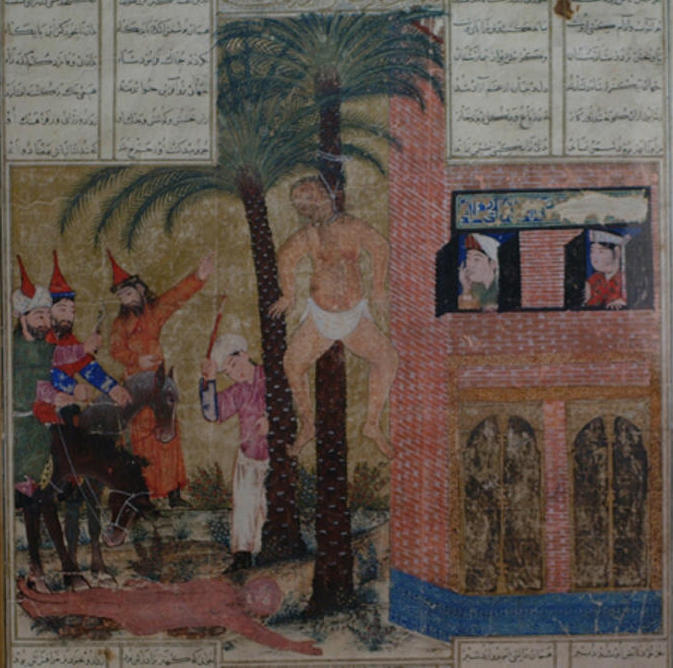Try Amazon Fresh

Amazon Audible Gift Memberships
Ilkhanid Illustration
Great Mongol (Demotte) Shahnama
Chapter Iskandar (14 years).
Shapur executes Mani.
Tabriz, Persia, c.1335AD

A larger image of 'Shapur executes Mani'. Great Mongol (Demotte) Shahnama. Tabriz, Persia, c.1335. Ilkhanid Illustration. Reza Abbasi Collection, Tehran.
Tehran, Riza Abbasi Museum
Title of Work: Shahnama (Great Mongol)
Manuscript: Ms 2530
Chapter 29 - Shapur Zul-aktaf (72 years)
Scene: Shapur executes Mani
English Title: Picture of Mani Hanging in a Tree
Dimensions (h x w): 280 x 284 mm
Format: Stepped within borders
Reconstructed Folio: 195v
Gregorian Date: 1335 (circa)
School: Tabriz, Ilkhanid period
Source: Shahnama Project
fig. 129. The Slaying of Mani, page from the Great Mongol Shahnama (Book of Kings), probably Tabriz, 1330s.
Ink and colors on paper.
Reza Abbasi Collection, Tehran
Al-Biruniís original text included a section on Zoroaster, curiously missing from the Ilkhanid copy, as well as one on the life of Mani.
The subject of Maniís execution seems to have captivated the Ilkhanids, for the scene is depicted both in al-Biruniís text,
where the illustration follows the Christian account of Maniís death by hanging, and in the Great Mongol Shahnama (Book of Kings) made a generation later,
where the illustration follows the traditional Muslim account of Maniís death by flaying (fig. 129).24
Here, Maniís flayed body lies on the ground, while his stuffed skin dangles from a palm tree.
At the right is the hospital mentioned in the text, with female onlookers peering out of the upstairs windows.
The group of onlookers on the left wear distinctive hats, tall, pointed, and brimmed.
Mongol envoys wore such hats (see fig. 68); they were depicted by European artists in a variety of settings,
ranging from the scene of Mongols eating their victims in a manuscript of Matthew Paris made about 124025
to the representation of Mongol envoys in Franciscan Martyrdom,
a fresco painted in the 1330s by Ambrogio Lorenzetti for the cloister of San Francesco in Siena.26
European artists put similar tall, pointed hats on many sorts of foreigners,
such as the money changers in the Temple in a Gospel book made in Verona in the late thirteenth century.27
The hats may have evolved into the tall ones typically worn by magicians and witches in the West.
24. Reza Abbasi Collection,Tehran; Grabar and Blair 1980, no. 46.
25. Cambridge, Corpus Christi College, Ms. 16, fol. 166a; illustrated in L. Arnold 1999.
26. For a Mongol emissary wearing such a hat, see Blair 2002. The Matthew Paris manuscript (Cambridge, Corpus Christi College, Ms. 16, fol. 166a) and the Lorenzetti fresco are illustrated in L. Arnold 1999, fig.I-2.
27. Vatican, Biblioteca Vaticana, MS lat. 39.
Source: p. 111, The Legacy of Genghis Khan Courtly Art and Culture in Western Asia 1256-1353
Previous: f. 190v: 'Narsi enthroned'. Great Mongol (Demotte) Shahnama. Tabriz, Persia. Ilkhanid Illustration. The Chester Beatty Library, Dublin, Per 111.6.
Next: f. 197v: 'Bahram Gur's mount tramples Azada'. Great Mongol (Demotte) Shahnama. Tabriz, Persia. Ilkhanid Illustration. Harvard Art Museums 1957.193.
Back to the Great Mongol (Demotte) Shah-Nameh. Tabriz, Ilkhanid Persia.


